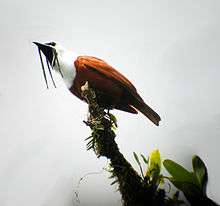Three-wattled bellbird
| Three-wattled bellbird | |
|---|---|
 | |
| male (left) and female (right) | |
| Scientific classification | |
| Kingdom: | Animalia |
| Phylum: | Chordata |
| Class: | Aves |
| Order: | Passeriformes |
| Family: | Cotingidae |
| Genus: | Procnias |
| Species: | P. tricarunculatus |
| Binomial name | |
| Procnias tricarunculatus (Verreaux & Verreaux, 1853) | |
| Synonyms | |
|
Procnias tricarunculata | |
The three-wattled bellbird (Procnias tricarunculatus) is a Central American migratory bird of the cotinga family. The sexes are very dis-similar in appearance. The male has a white head and throat and the remaining plumage is chestnut brown. From the base of his beak dangle three long, slender, black wattles that he uses in display. The female has olive plumage with yellowish streaked underparts and a yellow vent area.
The three-wattled bellbird breeds in montane regions of Costa Rica and migrates to western Honduras, Nicaragua and Panama, though its migration pattern is poorly understood. The male bird has a loud, distinctive, bell-like call, and as these birds are secretive and shy, they are more often heard than seen. The International Union for Conservation of Nature has assessed their conservation status as "vulnerable".
Description
One of four species of bellbird that live in Central and South America, the three-wattled bellbird is between 25 cm (9.8 in) and 30 cm (12 in) long. The body, tail, and wings of the male are uniformly chestnut-brown; its head, neck, and upper breast are white; and it has a black eye-ring, eye-stripe, and bill. Its name comes from the three worm-like wattles of skin that hang from the base of the bill. These wattles can be as long as 10 cm (3.9 in) when extended during songs and interactions. The wattles remain flaccid even when extended. The male shakes the wattles, but otherwise they hang straight down; they are neither erectile nor under muscular control. The side wattles do not stick out to the sides and the central one is not extended directly skywards as shown on some old illustrations and specimens. The female bellbirds are smaller and less striking in appearance, being overall olive with yellowish streaking below, pure yellow vent and no wattles.
Distribution
Famous for having one of the most unusual and distinct vocalizations of any bird in its range, the three-wattled bellbird exists from western Honduras south to eastern Panama. While little is known about the migratory behavior of these birds, they breed primarily in Costa Rican highlands (March–September) and return to lower elevations for the interim months.
Noise Making


Because of the secretive behavior of this bird, it is often only detected by the distinctive bell-like call given by the males. At close range, the vocalization of many in Costa Rica is heard as a complex three-part song, the "bonk" giving the bird its name. This hollow, wooden "bonk" is thought to be among the loudest bird calls on Earth, audible to humans from over 0.5 mi (0.80 km) away. The song is different in Nicaragua and in also Panama, and these songs also include an extremely loud, but less bell-like, note. The song may also be a short "Heee-Ahhh"
Research by Donald Kroodsma on recordings archived at the Cornell Lab of Ornithology showed that the three-wattled bellbird is unique among members of its sub-order, in that it learns its song, rather than having the song determined by instinct, because the song changed over the years that it had been recorded.
Status
The population trend of the three-wattled bellbird is on a downward trend because of destruction of the bird's forest habitat. The International Union for Conservation of Nature has assessed their conservation status as "vulnerable".[1]
References
- 1 2 BirdLife International (2012). "Procnias tricarunculatus". IUCN Red List of Threatened Species. Version 2013.2. International Union for Conservation of Nature. Retrieved 12 January 2016.
External links
Further reading
- Snow, D.W. (1982). The Cotingas: Bellbirds, Umbrella birds and their allies. British Museum Press. ISBN 0-19-858511-X
| Wikimedia Commons has media related to Procnias tricarunculatus. |
